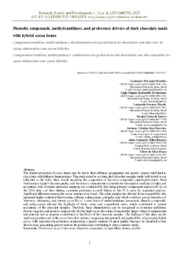Phenolic compounds, methylxanthines, and preference drivers of dark chocolate made with hybrid cocoa beans.
Phenolic compounds, methylxanthines, and preference drivers of dark chocolate made with hybrid cocoa beans.
Resumo: Abstract: The distinct properties of cocoa beans may be due to their different geographical and genetic origins which lead to chocolates with different characteristics. This study aimed to evaluate dark chocolate samples made with hybrid cocoa cultivated in the Bahia State, Brazil, regarding the composition of bioactive compounds (spectrophotometry, High Performance Liquid Chromatography) and the sensory characteristics (Quantitative Descriptive Analysis-QDA®), and acceptance test). External preference mapping was conducted by first using principal components analysis (PCA) on the QDA data, and then relating consumer preference (overall liking) to this PCA space by regression analysis. Significant differences among the cocoa varieties were found. Chocolate samples that showed lower acceptability also presented higher content of theobromine, caffeine, anthocyanins, and gallic acid which conferred greater intensities of bitterness, astringency, and intense cocoa flavor. Lower levels of methylxanthines, monomeric phenolic compounds, and anthocyanins allowed the highlight of fruity, sweet and caramelized notes, which contributed to greater acceptance of the chocolate samples. Therefore, these characteristics can be recognized as consumer preference drivers (negative and positive, respectively) for the high cocoa chocolates. It seems that higher values of ephicatechin and catechin had no negative contribution to the flavor of the chocolate samples. The findings of this study can be used in agriculture and in the cocoa/chocolate industry, suggesting the potential and applicability of promising hybrid cocoa, with important characteristics, representing a genetic material of great quality, that may be classified as fine flavor cocoa, associating greater value to the product, and contributing to meet consumer needs.
Ano de publicação: 2023
Tipo de publicação: Artigo de periódico
Unidade: Embrapa Meio Ambiente
Observações
1 - Por padrão são exibidas publicações dos últimos 20 anos. Para encontrar publicações mais antigas, configure o filtro ano de publicação, colocando o ano a partir do qual você deseja encontrar publicações. O filtro está na coluna da esquerda na busca acima.
2 - Para ler algumas publicações da Embrapa (apenas as que estão em formato ePub), é necessário ter, no celular ou computador, um desses softwares gratuitos. Sistemas Android: Google Play Livros; IOS: iBooks; Windows e Linux: software Calibre.
Acesse outras publicações
Acesse a Base de Dados da Pesquisa Agropecuária (BDPA) para consultar o acervo completo das bibliotecas da Embrapa.

